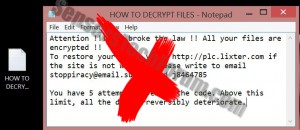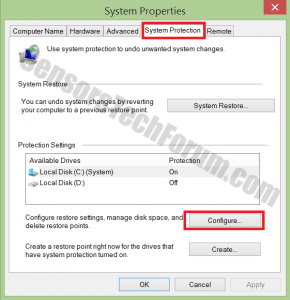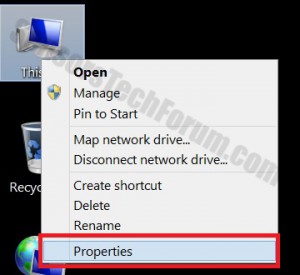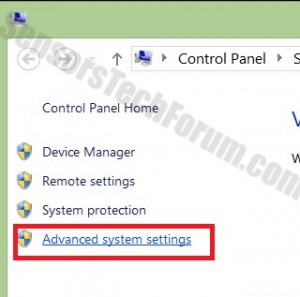| Name | CryptPKO |
| Type | Ransomware, Trojan |
| Short Description | CryptPKO encrypts significant user files, demanding most likely financial compensation ransom from the victim. |
| Symptoms | Encrypted files such as ‘document.docx.fd2342412’ that cannot be opened and ‘HOW TO DECRYPT FILES.txt’ object on the user desktop. |
| Infection Method | Via spam/spoof emails, using botnet computers. Via physical access to the PC. Via downloads from the internet. |
| Detection tool | Download SpyHunter, to See If Your System Has Been Affected By CryptPKO |
 CryptPKO is regarded as a Ransomware Trojan that encrypts important files and deploys HOW TO DECRYPT.txt file on the victim PC’s desktop. This dangerous threat may be distributed via many methods, main of which are via email, downloads from redirects or MITM attacks. This type of malware is very dangerous, and security officials report that in the .txt file there are ransom demands to decrypt the data along with contacts. Experts strongly advise against complying with the attackers’ terms and not to communicate with them by any means.
CryptPKO is regarded as a Ransomware Trojan that encrypts important files and deploys HOW TO DECRYPT.txt file on the victim PC’s desktop. This dangerous threat may be distributed via many methods, main of which are via email, downloads from redirects or MITM attacks. This type of malware is very dangerous, and security officials report that in the .txt file there are ransom demands to decrypt the data along with contacts. Experts strongly advise against complying with the attackers’ terms and not to communicate with them by any means.
How Did I Get CryptPKO?
Cyber criminals have become very smart in how they infect computers. Their attacks have become targeted mainly towards businesses and organizations. FBI have reported an estimate of 18 million dollars in losses from such attacks. Black hat hackers are believed to use botnets, which are networks of computers worldwide that are under their control, i.e. ‘zombie’ PCs. Via those, hackers conduct their attacks, mainly through spoof emails. This type of mail disguises the sender’s address, making it look like someone known to the recipient, increasing the likelihood of infection.
Once infected, the attacker may have full control over every move the victim does on the computer. However most attackers may tend to break connection with the victim PCs so that they cannot be traced back by law enforcement. Another method of infection from this hideous threat is man-in-the-middle type of attacks. In some cases, the attacker may physically install ransomware on an unmonitored computer in an organization.
What Does CryptPKO Do?
This ransomware is reported to encrypt mostly documents and other files, changing the name of the file as shown:
→document.docx to document.docx.i2dzqu
After which, it deploys a text document on the desktop of the PC with the following text:
→Attention !!! You broke the law !! All your files are encrypted !!
To restore your files visit https://plc.lixter.com if the site is not working, please write to email stoppiracy@email.su Your id f3424452
You have 5 attempts to enter the code. Above this
limit, all the data irreversibly deteriorate.
From this point, the files of the user that have been changed are not accessible via any software. They have been encrypted most likely with an encryption ranging from 2048 to 4096 bits. This kind of encryption is not an easy one to break if you do not have the proper decrypting software. In some cases, the files may even be replaced with other encrypted data and the original information could be stored only in the attackers’ hard drives.
After scanning the registries of an infected computer with CryptPKO security researchers have displayed in forums which registry keys and values were associated with this threat.
→ [HKEY_LOCAL_MACHINE\SOFTWARE\Classes\CLSID\{7444C717-39BF-11D1-8CD9-00C04FC29D45}] [HKEY_LOCAL_MACHINE\SOFTWARE\Classes\CLSID\{7444C717-39BF-11D1-8CD9-00C04FC29D45}\VersionIndependentProgID] [HKEY_LOCAL_MACHINE\SOFTWARE\Classes\CryptPKO.CryptPKO.1] [HKEY_LOCAL_MACHINE\SOFTWARE\Classes\Wow6432Node\CLSID\{7444C717-39BF-11D1-8CD9-00C04FC29D45}] [HKEY_LOCAL_MACHINE\SOFTWARE\Classes\Wow6432Node\CLSID\{7444C717-39BF-11D1-8CD9- 00C04FC29D45}\VersionIndependentProgID] [HKEY_LOCAL_MACHINE\SOFTWARE\Wow6432Node\Classes\CLSID\{7444C717-39BF-11D1-8CD9-00C04FC29D45}] [HKEY_LOCAL_MACHINE\SOFTWARE\Wow6432Node\Classes\CLSID\{7444C717-39BF-11D1-8CD9-00C04FC29D45}\VersionIndependentProgID] [HKEY_LOCAL_MACHINE\SOFTWARE\Classes\CLSID\{7444C719-39BF-11D1-8CD9-00C04FC29D45}] [HKEY_LOCAL_MACHINE\SOFTWARE\Classes\CLSID\{7444C719-39BF-11D1-8CD9-00C04FC29D45}\VersionIndependentProgID] [HKEY_LOCAL_MACHINE\SOFTWARE\Classes\CryptSig.CryptSig.1] [HKEY_LOCAL_MACHINE\SOFTWARE\Classes\Wow6432Node\CLSID\{7444C719-39BF-11D1-8CD9-00C04FC29D45}] [HKEY_LOCAL_MACHINE\SOFTWARE\Classes\Wow6432Node\CLSID\{7444C719-39BF-11D1-8CD9- 00C04FC29D45}\VersionIndependentProgID] [HKEY_LOCAL_MACHINE\SOFTWARE\Wow6432Node\Classes\CLSID\{7444C719-39BF-11D1-8CD9-00C04FC29D45}] [HKEY_LOCAL_MACHINE\SOFTWARE\Wow6432Node\Classes\CLSID\{7444C719-39BF-11D1-8CD9-00C04FC29D45}\VersionIndependentProgID]
Security experts strongly advise against manually removing any objects associated with CryptPKO ransomware, because they may initiate a script that will delete their files and, therefore, lose them
CryptPKO Ransomware Removal And Decryption
In case you have this ransomware installed on your computer, it is highly recommended not to comply with the ransom demands in any way and to seek immediately professional help. First, you should swiftly disconnect your equipment. After that, it is recommended to reboot the PC in Safe mode and download a reputable anti-malware program on a non-infected PC. You may use a USB flash drive to transfer the installer of the anti-malware program to your Safe Mode booted PC. After which it is advisable to scan your computer, and the anti-malware will remove any files associated with this ransomware.
IMPORTANT: Transfer a copy of the encrypted files to another USB flash drive before attempting any removals.
Also, here are easy step-by-step instructions to enable the Microsoft Windows Defense feature to backup your files and have the ability to restore them immediately to an earlier state before their encryption:
1) Download a particular anti-malware scanner and remove the CryptPKO files from the computer.
2) Open Properties by right-clicking on My Computer and then choosing it.
3) Open Advanced System Settings
4) Go to System Protection.

5) Mark the HDD partition on which you have necessary files, and you want to defend.
6) Click Configure and then click on Turn On System Protection.
7) Click OK and you are all set
After you have this protection switched on, if something happens to your data, you may be able to restore them, using those steps:
1) Right-Click the encrypted file and then choose Properties.
2) Click the Previous Versions button.
3) At this point, you should see an earlier version of the file with a ‘last modified’ date.
4) Mark the file with the mouse and then choose the down-right button that says Restore.
IMPORTANT:
If your files were previously encrypted, this software might leave some files, such as registry values and others on your system. This is why, recommendations are to download a particular anti-malware program that will ensure your protection and terminate any traces of the malicious software.

Spy Hunter scanner will only detect the threat. If you want the threat to be automatically removed, you need to purchase the full version of the anti-malware tool.Find Out More About SpyHunter Anti-Malware Tool / How to Uninstall SpyHunter
- Step 1
- Step 2
- Step 3
- Step 4
- Step 5
Step 1: Scan for CryptPKO with SpyHunter Anti-Malware Tool



Ransomware Automatic Removal - Video Guide
Step 2: Uninstall CryptPKO and related malware from Windows
Here is a method in few easy steps that should be able to uninstall most programs. No matter if you are using Windows 10, 8, 7, Vista or XP, those steps will get the job done. Dragging the program or its folder to the recycle bin can be a very bad decision. If you do that, bits and pieces of the program are left behind, and that can lead to unstable work of your PC, errors with the file type associations and other unpleasant activities. The proper way to get a program off your computer is to Uninstall it. To do that:


 Follow the instructions above and you will successfully delete most unwanted and malicious programs.
Follow the instructions above and you will successfully delete most unwanted and malicious programs.
Step 3: Clean any registries, created by CryptPKO on your computer.
The usually targeted registries of Windows machines are the following:
- HKEY_LOCAL_MACHINE\Software\Microsoft\Windows\CurrentVersion\Run
- HKEY_CURRENT_USER\Software\Microsoft\Windows\CurrentVersion\Run
- HKEY_LOCAL_MACHINE\Software\Microsoft\Windows\CurrentVersion\RunOnce
- HKEY_CURRENT_USER\Software\Microsoft\Windows\CurrentVersion\RunOnce
You can access them by opening the Windows registry editor and deleting any values, created by CryptPKO there. This can happen by following the steps underneath:


 Tip: To find a virus-created value, you can right-click on it and click "Modify" to see which file it is set to run. If this is the virus file location, remove the value.
Tip: To find a virus-created value, you can right-click on it and click "Modify" to see which file it is set to run. If this is the virus file location, remove the value.
Before starting "Step 4", please boot back into Normal mode, in case you are currently in Safe Mode.
This will enable you to install and use SpyHunter 5 successfully.
Step 4: Boot Your PC In Safe Mode to isolate and remove CryptPKO





Step 5: Try to Restore Files Encrypted by CryptPKO.
Method 1: Use STOP Decrypter by Emsisoft.
Not all variants of this ransomware can be decrypted for free, but we have added the decryptor used by researchers that is often updated with the variants which become eventually decrypted. You can try and decrypt your files using the instructions below, but if they do not work, then unfortunately your variant of the ransomware virus is not decryptable.
Follow the instructions below to use the Emsisoft decrypter and decrypt your files for free. You can download the Emsisoft decryption tool linked here and then follow the steps provided below:
1 Right-click on the decrypter and click on Run as Administrator as shown below:

2. Agree with the license terms:

3. Click on "Add Folder" and then add the folders where you want files decrypted as shown underneath:

4. Click on "Decrypt" and wait for your files to be decoded.

Note: Credit for the decryptor goes to Emsisoft researchers who have made the breakthrough with this virus.
Method 2: Use data recovery software
Ransomware infections and CryptPKO aim to encrypt your files using an encryption algorithm which may be very difficult to decrypt. This is why we have suggested a data recovery method that may help you go around direct decryption and try to restore your files. Bear in mind that this method may not be 100% effective but may also help you a little or a lot in different situations.
Simply click on the link and on the website menus on the top, choose Data Recovery - Data Recovery Wizard for Windows or Mac (depending on your OS), and then download and run the tool.
CryptPKO-FAQ
What is CryptPKO Ransomware?
CryptPKO is a ransomware infection - the malicious software that enters your computer silently and blocks either access to the computer itself or encrypt your files.
Many ransomware viruses use sophisticated encryption algorithms to make your files inaccessible. The goal of ransomware infections is to demand that you pay a ransom payment to get access to your files back.
What Does CryptPKO Ransomware Do?
Ransomware in general is a malicious software that is designed to block access to your computer or files until a ransom is paid.
Ransomware viruses can also damage your system, corrupt data and delete files, resulting in the permanent loss of important files.
How Does CryptPKO Infect?
Via several ways.CryptPKO Ransomware infects computers by being sent via phishing emails, containing virus attachment. This attachment is usually masked as an important document, like an invoice, bank document or even a plane ticket and it looks very convincing to users.
Another way you may become a victim of CryptPKO is if you download a fake installer, crack or patch from a low reputation website or if you click on a virus link. Many users report getting a ransomware infection by downloading torrents.
How to Open .CryptPKO files?
You can't without a decryptor. At this point, the .CryptPKO files are encrypted. You can only open them once they are decrypted using a specific decryption key for the particular algorithm.
What to Do If a Decryptor Does Not Work?
Do not panic, and backup the files. If a decryptor did not decrypt your .CryptPKO files successfully, then do not despair, because this virus is still new.
Can I Restore ".CryptPKO" Files?
Yes, sometimes files can be restored. We have suggested several file recovery methods that could work if you want to restore .CryptPKO files.
These methods are in no way 100% guaranteed that you will be able to get your files back. But if you have a backup, your chances of success are much greater.
How To Get Rid of CryptPKO Virus?
The safest way and the most efficient one for the removal of this ransomware infection is the use a professional anti-malware program.
It will scan for and locate CryptPKO ransomware and then remove it without causing any additional harm to your important .CryptPKO files.
Can I Report Ransomware to Authorities?
In case your computer got infected with a ransomware infection, you can report it to the local Police departments. It can help authorities worldwide track and determine the perpetrators behind the virus that has infected your computer.
Below, we have prepared a list with government websites, where you can file a report in case you are a victim of a cybercrime:
Cyber-security authorities, responsible for handling ransomware attack reports in different regions all over the world:
Germany - Offizielles Portal der deutschen Polizei
United States - IC3 Internet Crime Complaint Centre
United Kingdom - Action Fraud Police
France - Ministère de l'Intérieur
Italy - Polizia Di Stato
Spain - Policía Nacional
Netherlands - Politie
Poland - Policja
Portugal - Polícia Judiciária
Greece - Cyber Crime Unit (Hellenic Police)
India - Mumbai Police - CyberCrime Investigation Cell
Australia - Australian High Tech Crime Center
Reports may be responded to in different timeframes, depending on your local authorities.
Can You Stop Ransomware from Encrypting Your Files?
Yes, you can prevent ransomware. The best way to do this is to ensure your computer system is updated with the latest security patches, use a reputable anti-malware program and firewall, backup your important files frequently, and avoid clicking on malicious links or downloading unknown files.
Can CryptPKO Ransomware Steal Your Data?
Yes, in most cases ransomware will steal your information. It is a form of malware that steals data from a user's computer, encrypts it, and then demands a ransom in order to decrypt it.
In many cases, the malware authors or attackers will threaten to delete the data or publish it online unless the ransom is paid.
Can Ransomware Infect WiFi?
Yes, ransomware can infect WiFi networks, as malicious actors can use it to gain control of the network, steal confidential data, and lock out users. If a ransomware attack is successful, it could lead to a loss of service and/or data, and in some cases, financial losses.
Should I Pay Ransomware?
No, you should not pay ransomware extortionists. Paying them only encourages criminals and does not guarantee that the files or data will be restored. The better approach is to have a secure backup of important data and be vigilant about security in the first place.
What Happens If I Don't Pay Ransom?
If you don't pay the ransom, the hackers may still have access to your computer, data, or files and may continue to threaten to expose or delete them, or even use them to commit cybercrimes. In some cases, they may even continue to demand additional ransom payments.
Can a Ransomware Attack Be Detected?
Yes, ransomware can be detected. Anti-malware software and other advanced security tools can detect ransomware and alert the user when it is present on a machine.
It is important to stay up-to-date on the latest security measures and to keep security software updated to ensure ransomware can be detected and prevented.
Do Ransomware Criminals Get Caught?
Yes, ransomware criminals do get caught. Law enforcement agencies, such as the FBI, Interpol and others have been successful in tracking down and prosecuting ransomware criminals in the US and other countries. As ransomware threats continue to increase, so does the enforcement activity.
About the CryptPKO Research
The content we publish on SensorsTechForum.com, this CryptPKO how-to removal guide included, is the outcome of extensive research, hard work and our team’s devotion to help you remove the specific malware and restore your encrypted files.
How did we conduct the research on this ransomware?
Our research is based on an independent investigation. We are in contact with independent security researchers, and as such, we receive daily updates on the latest malware and ransomware definitions.
Furthermore, the research behind the CryptPKO ransomware threat is backed with VirusTotal and the NoMoreRansom project.
To better understand the ransomware threat, please refer to the following articles which provide knowledgeable details.
As a site that has been dedicated to providing free removal instructions for ransomware and malware since 2014, SensorsTechForum’s recommendation is to only pay attention to trustworthy sources.
How to recognize trustworthy sources:
- Always check "About Us" web page.
- Profile of the content creator.
- Make sure that real people are behind the site and not fake names and profiles.
- Verify Facebook, LinkedIn and Twitter personal profiles.



